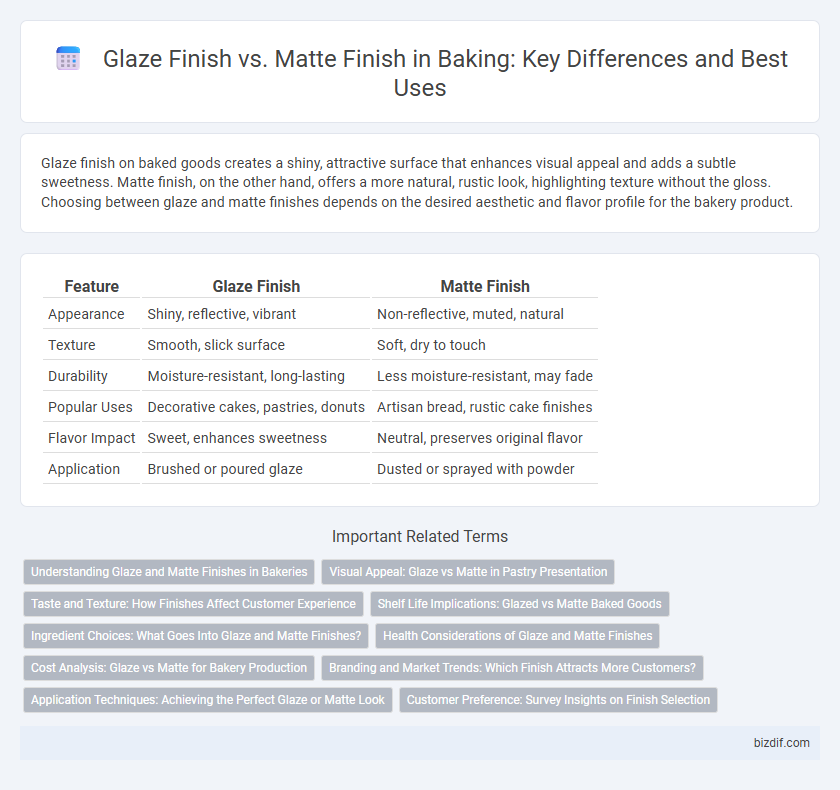Glaze finish on baked goods creates a shiny, attractive surface that enhances visual appeal and adds a subtle sweetness. Matte finish, on the other hand, offers a more natural, rustic look, highlighting texture without the gloss. Choosing between glaze and matte finishes depends on the desired aesthetic and flavor profile for the bakery product.
Table of Comparison
| Feature | Glaze Finish | Matte Finish |
|---|---|---|
| Appearance | Shiny, reflective, vibrant | Non-reflective, muted, natural |
| Texture | Smooth, slick surface | Soft, dry to touch |
| Durability | Moisture-resistant, long-lasting | Less moisture-resistant, may fade |
| Popular Uses | Decorative cakes, pastries, donuts | Artisan bread, rustic cake finishes |
| Flavor Impact | Sweet, enhances sweetness | Neutral, preserves original flavor |
| Application | Brushed or poured glaze | Dusted or sprayed with powder |
Understanding Glaze and Matte Finishes in Bakeries
Glaze and matte finishes in bakeries significantly impact the visual appeal and texture of baked goods, with glaze finishes providing a shiny, smooth surface that enhances freshness and sweetness perception. Matte finishes offer a soft, natural look with minimal shine, often preferred for rustic or artisanal bread and pastries that emphasize texture and ingredient qualities. Understanding the differences helps bakers choose the appropriate finish to align with product style, customer expectations, and marketing strategies.
Visual Appeal: Glaze vs Matte in Pastry Presentation
Glaze finish on pastries creates a shiny, reflective surface that enhances the visual appeal by making colors more vibrant and textures more enticing, often attracting customers through its glossy allure. Matte finish offers a subtle, sophisticated appearance, emphasizing the pastry's shape and intricate details without distractions from shine, appealing to minimalist or rustic presentation styles. Choosing between glaze and matte finishes depends on the desired visual impact and how the presentation aligns with the bakery's brand identity and target audience preferences.
Taste and Texture: How Finishes Affect Customer Experience
Glaze finish on baked goods creates a shiny, slightly sticky texture that enhances sweetness and adds a pleasant chewiness, making pastries more visually appealing and flavorful. Matte finish offers a more natural, rustic texture with a drier surface that allows the interior crumb's flavors to stand out without extra sweetness. Customers often perceive glazed items as richer and more indulgent, while matte-finished goods deliver a wholesome, less sugary taste experience.
Shelf Life Implications: Glazed vs Matte Baked Goods
Glaze finish on baked goods creates a protective barrier that helps retain moisture, significantly extending shelf life by preventing staleness and spoilage. Matte finish products, lacking this moisture-retentive coating, typically have a shorter shelf life and may require quicker consumption or refrigeration to maintain freshness. Choosing between glaze and matte finishes impacts product longevity, storage conditions, and overall quality retention in bakery items.
Ingredient Choices: What Goes Into Glaze and Matte Finishes?
Glaze finishes in bakery products are typically made from sugar syrups, corn syrup, and sometimes butter or cream to achieve a shiny, smooth surface that enhances visual appeal and adds sweetness. Matte finishes rely on alternative ingredients like powdered sugar, starches, or cocoa powder, providing a non-reflective coating that emphasizes texture without extra sweetness. The choice of these ingredients directly influences not only the appearance but also the flavor profile and mouthfeel of baked goods.
Health Considerations of Glaze and Matte Finishes
Glaze finishes on baked goods often contain sugars and artificial additives that can increase calorie content and pose concerns for individuals with diabetes or sugar sensitivities. Matte finishes, typically achieved with natural ingredients like powdered sugar or flour dusting, offer a lower-sugar alternative that reduces potential health risks related to excess sugar consumption. Choosing matte finishes can better align with health-conscious diets while maintaining appealing aesthetics.
Cost Analysis: Glaze vs Matte for Bakery Production
Glaze finishes in bakery products typically incur higher costs due to the additional ingredients like sugar syrups and the labor-intensive application process, which can increase production time and waste. Matte finishes, often achieved through baking techniques or minimal surface treatments, generally reduce expenses by using fewer materials and simplifying production workflows. Cost analysis shows that choosing a matte finish can improve profit margins without significantly compromising product appeal, whereas glaze finishes may justify their higher costs through enhanced visual impact and customer perception.
Branding and Market Trends: Which Finish Attracts More Customers?
Glaze finish, with its shiny and appealing surface, tends to attract more customers by enhancing visual appeal and perceived freshness in bakery products, aligning with current market trends favoring Instagram-worthy aesthetics. Matte finish offers a subtle, artisanal look that appeals to niche markets valuing authenticity and simplicity, often associated with premium or organic bakeries. Branding strategies favor glaze finishes for mass appeal and impulse buying, while matte finishes support brand identity centered on craftmanship and health-conscious consumers.
Application Techniques: Achieving the Perfect Glaze or Matte Look
Glaze finish in bakery involves applying a thin, glossy layer of sugar syrup, egg wash, or butter, often using a pastry brush or spray to create a shiny, appealing surface that enhances color and texture. Matte finish requires techniques like dusting with powdered sugar, cornstarch, or flour, or using a dry brushing method to maintain a soft, rustic, and less reflective appearance ideal for artisan breads and pastries. Mastery of temperature control and timing during application ensures the glaze sets correctly without melting, while matte finishes benefit from minimal moisture to preserve their natural, understated look.
Customer Preference: Survey Insights on Finish Selection
Survey data reveals that 68% of bakery customers prefer a glaze finish for its appealing shine and perceived freshness, while 32% opt for a matte finish due to its rustic and artisanal look. Insights indicate glaze finishes boost visual appeal and often increase impulse purchases, whereas matte finishes attract customers seeking natural or less processed aesthetics. Understanding these preferences helps bakeries tailor product presentation to enhance customer satisfaction and sales.
Glaze finish vs Matte finish Infographic

 bizdif.com
bizdif.com